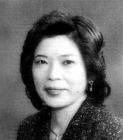The art of handwriting, well-respected in the East, and almost forgotten in Russia, is starting a new life. Masters of calligraphy, the genuine keepers of the art, recently only taught in art schools, have taken their pens and brushes and got ready to demonstrate the beauty and power of a handwritten word to the world. Supporting the Russian Project, the prominent calligraphers from Japan profoundly explain the significance of a sign in art and everyday life.
About Japanese calligraphy:
“Shodo” - the way of writing
Japanese calligraphers
Kayidsi Onodera
President of the Japanese calligraphers Association. Author of the project "Word and brush"
Shoen Iwao
The pseudonym of Teruko, born in 1941, independent participant.
"Jumping and Dancing" (135x70)
The Swan Lake ballet was my first association with Russia, thus I decided Dance would be the theme of my work. As far as I am not of frail constitution it was a challenging task for me to convey the waff of motion with a brush.
Suisen Nakatani
The pseudonym of Hiroku; born in 1946, the employee of the Gennitikai association and Ruyunsya society.
"The Sun and the Moon" (140x70)
For three years I have been developing the theme of peace. This is one of the sequences of works. “Neither the Sun, nor the Moon would fall down on Earth”. I liked the phrase. The signs of “moon” and “sun” give the idea of time.
Tessen Sasaki
Pseudonym of Nobuo; born in 1930; the Head of the Japanese Academy of Calligraphy, chirographer.
"Car" (220x54)
The “car” sign is taken from the inscriptions on ancient ceramics. The main purpose was to introduce people unfamiliar with hieroglyphic culture to the beauty and joy of signs.
Daika Harakon
"Guze Kannon" (200x75)
Secret image of Buddha, the national treasure of the Asuka Period which is said to be the image of prince Sutoku. The image has been the object of mystic worship for 1200 years until Ernest Fenolloza uncovered it in year 17 of the Meiji Era.
Shuko Yanagidsawa
"A Poem of Huang Tingjian" (205x69)
“Ancient scripts echo in my heart”. I love these words which very well describe my impressions of classic books. They attract us with their ornamental style which is very close to ancient signs and gives the measure of feelings and emotions.
Ichiyo Nariyama
"Essence of Spring" (227x53)
I have chosen the lyrics by Natsume Soseki, the foremost Japanese novelist of the Meiji Era, describing human admiration of the beautiful spring landscapes. The work is executed on rose- pink leaf-gold. I was trying to depict the spring time when human souls revive and the snows melt.
Shiko Kataoka
"Thirty Six Masters of Classical Japanese Poems" (200х60х3)
16 tankas from the collection of ancient Japanese lyrics written on two scrolls of fine Japanese paper. I wished I could convey the rich culture of Japan through poems, cannah signs and the beauty of application.
Kinryu Asami
"Dragon and Tiger" (120x60x2)
Ancient Chinese signs depicted by means of modern calligraphy.
Seison Suzuki
Seison’s Monologue “The Essence of Japanese Culture” (135x90)
Hieroglyphic and cannah writing have become the flesh and blood of every Japanese man. Popularize it all over Japan, make it a piece of art intelligible for everyone, forget about the age and concentrate on accomplishing the goal. Can one person handle it all?
Banjo Taneya
"Idleness" (138x70)
The charm of ancient signs. In this work I tried to apply the ancient ornament styles tansyo and raisyo. I took the silk inscriptions of the early Han Era as the sample.
Applying liquid ink, paint blots, slight brush strokes and tangled lines I tried to create a sense of volume.
Toshu Teraoka
"Cherry Blossom on a Moonlight Night" (150x60x2)
I have chosen two poems about flowers by Akiko Yosano and Tekkan Yosano. Creating the contrast between the “vivid”, “rhythmic” signs of the work in general and the word “misebaya” written with separate signs I was trying to give harmony.
Tokoku Harada
"The Sea Reflecting The Light" (187x89)
I am standing at the seashore looking at the sea surface reflecting the light. The spots of light are flashing and fading. This eternal game of Nature is fascinating and heals the soul. The ink drops are shooting up tracing the brush. A brush in a hand is the everlasting source of energy.





























